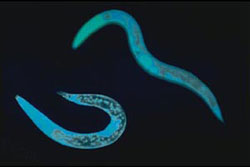
Caenorhabditis elegans , a nearly transparent nematode (round worm) about one millimeter long, is rasied by the thousands in laboratory petri dishes. C. elegans is used for studying the genetics of development and other physiological processes including nerve function and aging. Its transparent body allows researchers to see and image stages of development. Its genome has been sequenced, which also recommmends the little worm to researchers, as does its short life cycle—it develops from a single cell to an adult in less than four days.
On
the biological importance of studying wiggly living things:
"I think that has also proved to be one of the worm’s successes—that somebody could come into a lab with very simple apparatus. That is, the hurdle to enter the field was very low—you just needed a dissecting microscope—and within a few weeks you could be doing significant biological experiments on your own! And for young students, this is what you need to get them interested in the field." — Sydney Brenner , Research professor, Salk Institute For more information on C. elegans as a model organism, see the C. Elegans WWW Server , from the University of Texas Southwestern Medical Center. |
||||||

 On
establishing
C. elegans
as a model organism:
On
establishing
C. elegans
as a model organism: